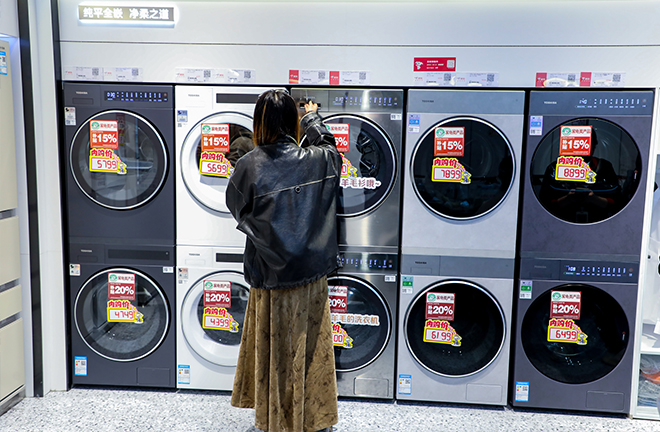Strengthening domestic circulation vital to sustained growth

A consumer compares washing machines on April 5 at a shopping mall in Shanghai, where state trade-in subsidies were implemented to stimulate consumption. Photo: IC PHOTO
China’s State Council recently convened a meeting to advance efforts in strengthening domestic circulation. The meeting emphasized the need to “fully understand and accurately steer the development of the Chinese economy at its current stage, with a focus on strengthening domestic circulation and making it the strategic foundation for economic growth.” The meeting also called for efforts to “leverage the inherent stability and long-term growth potential of domestic circulation to offset the uncertainties in the international market, in order to steer the country’s economy toward long-term stability and progress and achieve high-quality development.”
Scholars regard domestic circulation as both the central driver and strategic engine of China’s push to foster a new development paradigm. Thanks to its unique resilience in the face of external shocks, domestic circulation plays a critical role as a “stabilizer” and “ballast stone” within the new development paradigm of “dual circulation.”
Significance of domestic circulation
The dual circulation strategy, introduced by the CPC Central Committee in 2020 amid rising global uncertainties, places domestic circulation at its core. Under this framework, the domestic market serves as the mainstay, with domestic and international markets complementing and strengthening each other. Achieving this vision depends on a robust domestic economic circulation system and strong economic fundamentals.
“Major economies typically enable domestic demand to be a leading driver and the domestic market to thrive,” said Liu Fang, a research fellow from the Academy of Macroeconomic Research at the National Development and Reform Commission, further noting that China is a super-large economy with a solid foundation for domestic circulation, alongside ample space and vast potential for development.
“From the perspective of demand, China has a population of more than 1.4 billion, and its per capita GDP has exceeded $12,000, making it the world’s most promising consumer market. In terms of supply, China has established the most complete and largest industrial system globally, fostering strong production capacities,” Liu explained.
Liu highlighted the need to accelerate the development of a well-structured domestic demand system and to fully harness both the demand advantages of China’s massive market and the supply strengths of its complete industrial system, thereby forming an economic cycle primarily driven by domestic circulation.
Shen Kaiyan, director of the Institute of Economics at the Shanghai Academy of Social Sciences, elaborated on the urgent need to strengthen domestic circulation. In the face of rising trade protectionism and the global value chain’s ongoing restructuring, promoting domestic circulation offers a way to mitigate international uncertainties through internal stability and sustained growth. It will reduce excessive reliance on foreign markets and resources, enhance economic autonomy and independence, enable the country to seize the initiative for growth, and foster greater self-reliance and strength—thereby laying a solid foundation for long-term, stable economic development.
Shoring up weaknesses
As General Secretary of the CPC Central Committee Xi Jinping stressed, “the key to building a new development pattern is to ensure unimpeded economic flow.” In interviews with CSST, scholars identified significant challenges within the Chinese economy, including a mismatch between supply and demand, inefficient resource allocation, and hindered factor mobility.
Luo Zhe, president of the Gansu Academy of Social Sciences, underscored two major obstacles to domestic circulation. First, there is inadequate support for domestic circulation itself. Second, insufficient domestic demand—particularly consumer demand—combined with a low consumption rate and persistent structural imbalances between consumption and investment, have weakened the economy’s endogenous growth drivers. He also noted that within the domestic economic cycle, issues such as urban-rural disparities, limited market-oriented operations, and low resource allocation efficiency remain pronounced in the factor market.
In recent years, the growth of China’s household consumption has slowed, and consumption’s foundational role in driving economic growth remains underutilized. Li Shenglan, deputy director of the Institute of Free Trade Zones at Sun Yat-sen University, pointed out that pressures on residents’ income growth, in addition to uneven income distribution and significant urban-rural and regional disparities, have constrained overall spending power.
Shen also shed light on under-consumption. “On one hand, decelerated growth of residents’ income, large income gaps, limited spending power of low- and middle-income groups, an imperfect social security system, and residents’ strong desire for precautionary savings have restricted consumption potential. On the other hand, lagged upgrading of spending structure and insufficient supply of high-quality, personalized, and green products have made it difficult to meet consumer needs for consumption upgrades.”
Shen told CSST that challenges related to factor mobility, institutional environment, and regulatory policies have hindered the optimal allocation of resources and contributed to a disorderly market environment, which undermines fair competition and industrial development.
“Despite multifold pressures, the Chinese economy still possesses the edge of a super-large market and huge domestic demand potential. Through expanded domestic demand and optimized supply, domestic circulation can unlock the potential of domestic economic development, rectify the imbalance between supply and demand, and reinforce the fundamental role of consumption and the key role of investment in growth, forming a virtuous cycle where consumption and investment promote each other,” Shen said. She believes that by coordinating domestic demand expansion and supply-side reform deepening, technological and industrial innovation, regional coordination and open cooperation, China can seize the initiative amid shifting global economic conditions.
Zha Jianguo, Zhu Yi, Ming Haiying, and Chen Lian contributed to this story.
Edited by CHEN MIRONG
